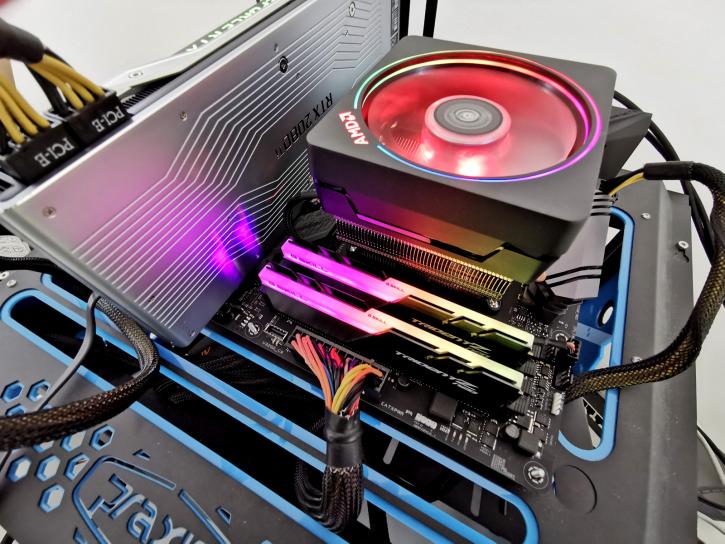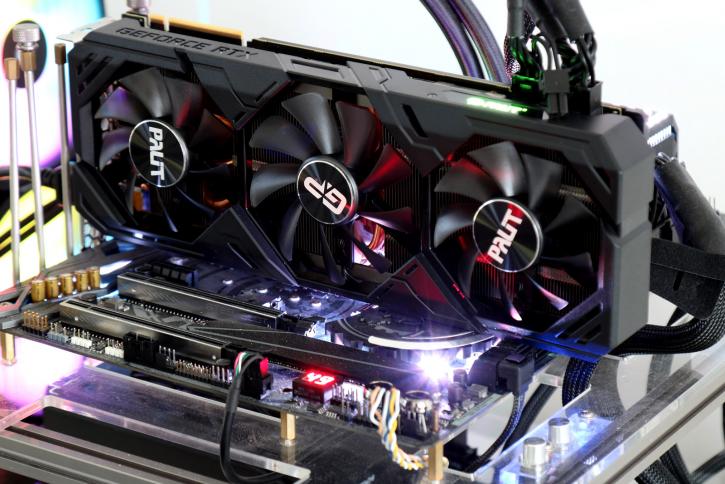The High-End Build
The High-End Build - $ ... it’s complicated
The modern hardware scene has upset the normal sense of perspective on the price of individual PC builds. The cost of high-end GPUs in 2020 has meant that a solid ‘base’ PC is a secondary consideration when you need to account for a $500+ GPU just to have something ‘high-end’. Remember, in 2015-16, $550-650 would have gotten you ‘the best’, namely the GTX 980Ti or Fury X. Now that AMD doesn’t offer anything faster than the 5700XT, Nvidia is free to charge what they please. My point is that whilst my pricing ‘aim’ for this system is around $1,300, the reality is that you could simply add a faster GPU to the mid-tier build listed previously and you would, realistically, enjoy much the same performance as would be seen here. This computer, then, is about ‘bulking out’ the experience as a whole, rather than trying to extract the maximum price vs. performance that is possible. With that, onwards.
CPU – AMD Ryzen R7 3700X (3800X if ‘reasonably’ priced) or Intel Core i7 9700k
It is my view that – without hyperthreading – the i7 9700k is not a good buy in 2020. I really do not think it will be that long before high processor usage on said chip is a limiting factor in gaming in 2020 and beyond (even if paired with a ‘reasonable’ GPU, e.g. an RTX 2070 Super or RX 5700XT). That is why my ‘nod’ has to go to AMD, here, and their excellent value R7 3700X (review). 8 cores, 16 threads, highly tuned out of the gate, a mere 65W of TDP, and – though your mileage may vary, here – a decent boxed cooler. Whilst I would have little issue (none, in fact) building a PC in this price range with a CPU like the R5 3600, the 3700X is better suited to the task, realistically.
The 3800X (review) is the ‘odd cousin’ of the Zen 2 line up. The initial $100 extra lets you have a 300Mhz higher base clock and 100Mhz higher boost clock, albeit for an additional 40W of TDP. If you can find the 3800X for a reasonable price, though, it might be worth paying the $30-40 extra. If the 3700/3800X CPUs aren’t available where you are, then my choice for a high(er)-end gaming system in 2020 would be the 9700k from Intel. 8 fast Intel cores overclocked to north of 5Ghz is still extremely potent, and the lack of hyperthreading (whilst not ideal) should not be an immediate concern.
It is, notably, around $60-70 more expensive than the 3700X and doesn’t come with a cooler. Intel’s 9th generation chips also run relatively hot, especially when overclocked, so solid cooling is a necessity. I’ll make it clear, here, before I upset anybody. The Core i7 9700k (review)is an excellent CPU, and were the 3700X not around, it would get the unwavering nod of every single reviewer around. That said, the 3700X is very much ‘around,’ and – as a result – it must be my recommendation.
Motherboard - Intel, Gigabyte Z390 Aorus Master or AsRock Z390 Steel Legend
The Steel Legend is, perhaps, our favourite mid-range Z390 option. Really, it's only 'of note' letdown was the presence of some hotspots when overclocking a 9900k to north of the 5Ghz barrier. This would be very much more tamed in a case with active airflow. Otherwise, we like the board for covering most points well enough to be a strong consideration for a high-end build that doesn't break the bank. Sure, it doesn't have Wifi, but that - even in 2019 - is not that unusual! It also ships with a slightly older ALC 1200 audio codec, over the slightly newer 1220 codec. However, ask yourself if these bother you? They really shouldn't. The Steel Legend will be more than capable of 5Ghz'ing' a 9700k, without a problem. If, however, these shortfalls do annoy you, then. It's fair to say that Aorus really, really knocked it out of the park with their Z390 range of boards. Our higher-end pick of the bunch is their 'Master' board, which - putting everything else aside - is perhaps my favourite looking motherboard released in modern times. Sure, it's got RGB aplenty, but even with said lighting off, it still looks absolutely fantastic. Add to this 3x M.2 slots, wireless networking, and a very strong VRM, and you have a very premium board that will also tame a 9900k without any kind of a problem, should you find yourself needing to scratch that upgrade itch before long.
- AsRock X570 Steel Legend (WiFi)
- MSI B450 Tomahawk Max
- Asus Prime Z390
Zen 2 chips can run on all B450 series motherboards that have an up to date BIOS, so X570 motherboards aren’t strictly necessary. The budget for this build, though, does allow for more breathing room, so AsRock’s X570 ‘Steel Legend’ board makes our recommendation, here. What attracts us to the Steel Legend is the decent voltage regulation, build quality, M.2 options, I/O, and pricing.
If you want to spend less, then our recommendation goes to MSI’s excellent B450 Tomahawk ‘Max.’ The original Tomahawk was already a popular product, thanks to the decent VRM, build quality, and onboard BIOS flashback capability. This option will save you $70-80 USD and you will lose next to nothing in terms of performance. There are some caveats, though:
- B450 motherboards may not support Zen 3 (releasing, supposedly, in Q4 2020);
- You lose PCIe Generation 4 support;
- High core count processors (e.g. the 3900X/3950X, or a Zen 3 high core count CPU) will require adequate airflow over the board’s VRM, to ensure there is no thermal throttling.
For most, I would actually argue that the B450 board is the smarter choice. After all, if price vs. performance is what we are after, here, then the limited extra performance potentially offered on the X570 platform for CPUs like the 3700X/3800X mean that the X570 option is a luxury, not a ‘given’. What if you decide to go for Intel’s i7 9700k? Well, there, our recommendation goes to Asus’ Z390-A ‘Prime’ motherboard. I have had personal experience with this product and can give it a very hearty recommendation. The build quality, looks, features, and pricing are – in my view – worthy of a board at least $100-120 more expensive, and the UEFI/BIOS is excellent.
The high entry price point for even mid-range X570 boards means that a very popular option for Zen 2 based PC builders is... well, going back in time! B450 and X470 boards, with a BIOS update, are more than capable of supporting the 7nm Zen 2 chips. So which should you go for? Well, I am very firmly of the opinion that if you are buying into an older platform, then you should be spending as little as possible. Therefore, my recommendations will carry over from our 'mid-range' PC build. Depending on your case choice, go with the aforementioned Tomahawk, Mortar, Bazooka, or B450-F Strix.
Cooler
For AMD buyers, this section is optional. The 3700X and 3800X come with an adequate cooler in the ‘Wraith Max RGB.’ It has been reported, however, that it can be audible if heavily pushed, and I am aware that certain people are more sensitive and/or bothered by certain types of noises than others. For 9700k buyers, you must buy a cooler as the 9700k does not come with one. Readers of my previous build guides (and, for that matter, CPU cooler reviews) will know that I am a strong advocate for air cooling unless high-end AIOs or custom loop water-cooling is required. I will not direct you to a single component, here, as someone’s cooling requirements will depend entirely on their CPU of choice and whether they are overclocking.
Please see here for Guru3D’s list of CPU cooler reviews.
The minimum you should be looking at, in my view, is a 240mm unit. Simple as that, or up to 280mm. The cooling performance of c. 95% of these AIO units will be largely down to the fans that get stuck on the radiator, and you choose to configure them. As for what to go for, two have received high praise in the tech industry for their looks and performance, and the third is a personal recommendation of mine:
- Corsair H100i/115i RGB Platinum - If you like Corsair products, you will like this cooler. Personally, I think that Corsair's software is a serious leg up on NZXT's, which means that this would (probably) be my choice. The bundled fans are nice as well, giving your PC an appropriate lightshow.
- NZXT Kraken X52/62 V2 - This unit from NZXT is well known to be a looker, and whilst their CAM software is well known to be a bit hit and miss, my experiences with it have largely been positive. The cooler is priced competitively with its rivals, and - to boot - performs well.
- Fractal Design Celsius S24 - Whilst this product is certainly getting on in years, do not discount it. The other coolers are flashier, will perform better, and are more modern... however, the S24 is whisper quiet, is great looking, and will certainly tame a PBO enabled 3700X, or be able to moderately overclock a 9700k.
Naturally, there are other coolers, but the ones I have listed are from companies I trust. Another worthy shout out should go to Deepcool's 'Castle' series of coolers, specifically the 240/280/360EX. Not only is it - in my view - one of the best looking products in this segment, but it has a neat trick in Deepcool's 'Anti-Leak' tech, which is basically a pressure equalising bladder inside the radiator that expands/contracts to maintain loop pressure within an acceptable range, preventing pressure related leaks. Sure, it won't stop the potentially of leaking full stop, but I still feel like this is important, as liquid cooling is always going to be inherently riskier than air cooling, simply due to the fact that an AIO has multiple times the numbers of points of failure.
RAM – AMD & Intel, 16GB DDR4 3600Mhz (CL16)
Given that we are now going for a Zen 2 processor (with no consideration for Zen+), DDR4 3600Mhz CL16 is our firm recommendation, and that is what you should be buying. Whilst significantly higher RAM speeds than this have been seen on Zen 2 processors, there is no guarantee they will work, and you will more than likely run into stability issues unless you know exactly what you are doing. As for Intel processors, again, there is little point paying disproportionately higher amounts for faster RAM than 3600Mhz, despite the fact that Coffee-Lake S processors can certainly support it.
Storage –Western Digital Blue SN550/Samsung 970 Evo or Team Group Cardea Z440
Bearing in mind the use case for this PC as a purely gaming focused computer, DRAM-less SSDs (i.e. SSDs that do not have any form of DRAM cache) aren’t going to pose a problem. Therefore, I have little hesitation in recommending the Western Digital SN550 1TB as a ‘base’ drive for this build. For $120, you get 1TB of fast NVMe storage. I really do not see any downside to this, and – for gaming – you will find no task that bogs down the drive due to its lack of DRAM cache. What about if you wanted to stay with Generation 3 drives, but get ‘the best’? Well, for around $50-60 over the SN550, you can get Samsung’s much loved 970 Evo. Though a little ‘old’, the 970 Evo has been long-lived for a reason. Incredibly fast, reliable, decent value, and highly resilient (i.e. high endurance), it is an often-seen product in builds, and I see no reason to shy away from recommending one. What about PCIe Gen 4? Well, our recent review of Team Group’s ‘Cardea’ Z440 (review here) was a real eye opener. Team Group have been around for a little while, and I have reviewed some of their
2.5’’ SSDs and (very memorably) a 16GB RAM kit that proved quite the challenge to overclock on my then R7 1700X based system. The Z440, though, is a superb product. Reasonably priced (for a 1TB Gen 4 NVMe SSD), it impressed in Hilbert’s testing and becomes our recommendation for a Gen 4 drive.
Check out our many SSD storage reviews here,
Power Supply
Our recommendations boil down to the following units:
- Corsair ‘RMx’ (2018) 650W;
- Corsair ‘TX-M’ 650W;
- Thermaltake ‘Toughpower’ Gold 650W;
- Cooler master MWE Gold 650W.
PSU availability is, as said earlier, a problem in 2020. However, when you’re spending upwards of $1,300-$1,500 on a PC, I would argue that an additional $40-50 premium on a PSU during these times isn’t a big sacrifice to make.
No specific recommendations for a case, here. I generally recommend spending no more than 10% of your total build budget on a case, and certainly do not spend money that could go on a better CPU, GPU, RAM, or storage.
GPU – AMD Radeon RX 5700XT, Nvidia RTX 2070 ‘Super’, Nvidia RTX 2080 Super
Variants of the Radeon RX 5700 XT (review) can be found for around $400 USD, and so whilst the recommendation for the 5700XT is a general one, the model I would choose would be Gigabyte’s RX 5700XT Gaming ‘OC’, a three-fan card that impressed many. Whilst we did not get to sample the unit ourselves, the opinion of multiple other publications is enough for me to recommend the card.
Please be assured that I am entirely objective when I recommend the AMD GPU over the Nvidia 2070 Super (review). The performance between the two is either very similar, or the Nvidia card pulls around 10% ahead. For the sake of up to $100-150 extra for the 2070 Super, the Nvidia card seems like poor value.
With that said, I do understand why people may wish to pay the premium for the marginally faster Nvidia card. To that end, our firm recommendation would go to EVGA’s ‘Black’ Gaming card for c. $510-515 USD. Beyond this, I do not recommend anyone pay more than this, as you further venture into the territory of ‘poor value’ when you pit it against the 5700XT.
My recommendations are borne out of wanting to get you the best performance possible for the price paid and, in my mind, the 5700XT is the value proposition in the mid-high tier GPU shootout. Both GPUs, however, are good buys and can handle 1440p high-refresh rate gaming with relative ease.
What about if you wanted to ‘step up’ this PC to the next level? Easy, drop in Nvidia’s RTX 2080 ‘Super’ (review). Starting out at $700, it is by no means a cheap GPU, but the ‘Super’ variant of the 2080 represents better value than the original 2080 did.
I would have no issue pairing the 2080 Super with a 9700k or R7 3700X/3800X, especially at 1440p. Would you get superior performance with the 9900k or 9900KS at either 1080p or 1440p? Yes. Is it worth the additional cost for the CPU, upgraded cooling, and motherboard? Probably not.



